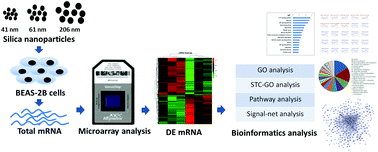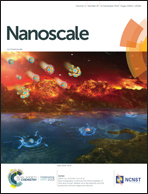Microarray-assisted size-effect study of amorphous silica nanoparticles on human bronchial epithelial cells†
Abstract
Amorphous silica nanoparticles (SiNPs) are not only abundant in nature, but also the second largest engineering nanomaterials in terms of annual output. Respiratory exposure is the main route for SiNPs to enter the human body. A large number of studies have focused on the respiratory toxicity of SiNPs and demonstrated that SiNPs could induce pulmonary tissue damage, inflammation, fibrosis, and even the malignant transformation of bronchial epithelial cells, while the size-dependent toxicity of SiNPs and their underlying biological mechanisms remain unclear. In this regard, a transcriptomics study would be conductive to gaining a better understanding of the toxic mechanism. In the present study, microarray analysis was performed to investigate the genome-wide transcriptional alteration induced by different sizes of SiNPs in human primary bronchial epithelial cells (BEAS-2B). To determine the effect of the particle size on the toxicity, nanoparticles of two sizes (41 nm and 61 nm) and submicron particles of one size (206 nm) were introduced. The bioinformatics analysis results indicated that: (1) the number of differentially expressed genes in the three SiNP-treated groups increased with the particle size decreasing; (2) the genes involved in the immune and inflammatory response, gene expression, signal transduction, endoplasmic reticulum stress, oxidative stress, cell metabolism, and cell proliferation were gradually upregulated with the particle size decreasing, while the genes related to the morphological development of the respiratory system were gradually downregulated with the particle size decreasing; (3) the modes of action of the two nanoparticles overlapped with each other to some degree, and there existed many different modes compared to those from the submicron particles; (4) both the silica nanoparticles affected the pathways associated with the cell entry of silica nanoparticles, autophagy and lysosomal dysfunction, endoplasmic reticulum stress, inflammatory response, DNA damage, and gene expression, as well as apoptotic resistance and cancer. To the best of our knowledge, this is the first study that has reported the alteration trend of gene expression profiles with the change in silica particle size. Our study provides a great deal of information on the toxic mechanisms underlying the respiratory toxicity induced by SiNPs, and can also serve as an experimental basis for the toxicity and safety evaluation of silica nanoparticles.



 Please wait while we load your content...
Please wait while we load your content...